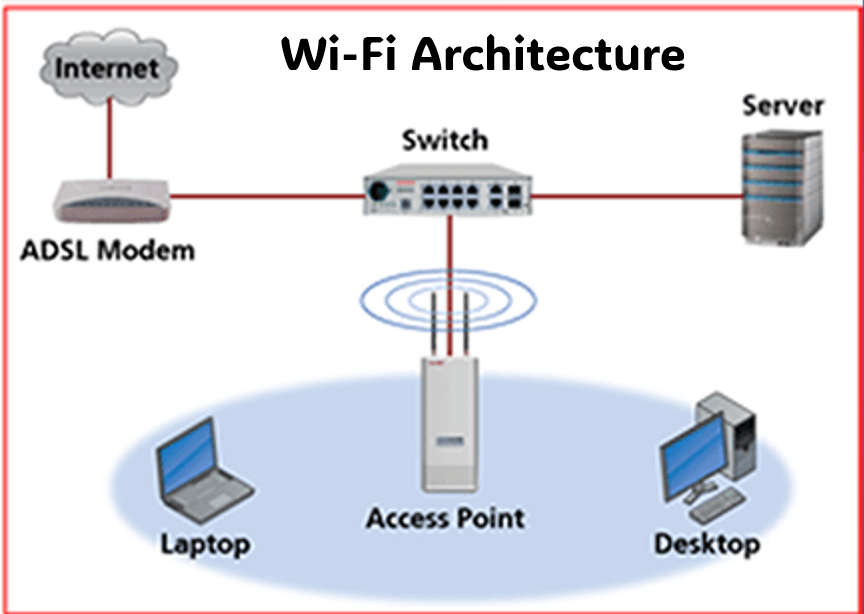Introduction
In today’s digital age, Wi-Fi technology has become an indispensable part of our lives. It enables us to connect to the internet, share data, and communicate seamlessly across many devices. Its various standards, its role in computer networks, the different types of Wi-Fi, and a look at its underlying architecture.
What is Wi-Fi Technology?
It operates over radio waves, enabling data transmission through the air providing flexibility and mobility in our connected world. Wi-Fi technology has revolutionized how we work, play, and stay connected in the modern era.
Different Wi-Fi Standards

The evolution of Wi-Fi technology has given rise to various standards, each offering different speeds, ranges, and capabilities. Some of the prominent Wi-Fi standards include:
802.11b:
This was one of the earliest Wi-Fi standards, offering speeds of up to 11 Mbps in the 2.4 GHz frequency range. It is now considered outdated but played a crucial role in popularizing Wi-Fi.
802.11a:
Operating in the 5 GHz frequency range, this standard provided faster speeds, up to 54 Mbps. However, its shorter range limited its widespread adoption.
802.11g:
Combining the best of both worlds, 802.11g offered speeds of 54 Mbps while operating in the 2.4 GHz frequency range, ensuring compatibility with older 802.11b devices.
802.11n:
A significant advancement, 802.11n introduced MIMO (Multiple Input, Multiple Output) technology, which boosted speeds to 600 Mbps and improved range.
802.11ac:
Also known as Wi-Fi 5, this standard provides even faster speeds, up to 1.3 Gbps, thanks to advancements like broader channel bandwidths and beamforming. It operates solely in the 5 GHz band.
802.11ax:
Commonly referred to as Wi-Fi 6, this standard takes wireless performance to new heights. It offers higher speeds, lower latency, and improved efficiency, making it ideal for handling the increasing demands of modern networks.
How a Wi-Fi Network Works: A Step-by-Step Guide
1. Device Connection:
Wi-Fi networks begin with devices like smartphones, laptops, or tablets seeking available networks.
2. Scanning:
Devices scan for nearby Wi-Fi signals, identifying network names (SSIDs) broadcasted by routers or access points.
3. Authentication:
Authentication is required when a user selects a network. This often involves entering a password to establish trust.
4. Association:
Once authenticated, the device associates with the chosen network, creating a connection with the router or access point.
6. Data Transmission:
Data packets are sent between the device and router, often using radio waves in the 2.4GHz or 5GHz frequency bands.
7. Routing:
The router directs data to its destination, whether it’s another device within the local network or the broader internet.
8. Security:
Wi-Fi networks employ encryption and security protocols to protect data in transit.
9. Continuous Communication:
Devices stay connected as long as they are within range and maintain a stable signal, enabling seamless data exchange.
Wi-Fi in Computer Networks
Wi-Fi is pivotal in computer networks, facilitating wireless communication between devices. In a typical Wi-Fi network, a wireless router or access point is the central hub, transmitting data to and from connected devices.
Types Of Wi-Fi Technology:
Wi-Fi technology isn’t limited to a single type; rather, it encompasses various types, each designed for specific use cases:
Home Wi-Fi:
This type of Wi-Fi is tailored for residential use. It provides internet access to devices within a home, enabling activities like streaming, gaming, and web browsing.
Enterprise Wi-Fi:
In contrast, enterprise Wi-Fi is designed for large-scale deployments in businesses and institutions. It offers advanced security features, scalability, and support for many simultaneous users.
Public Wi-Fi:
Public Wi-Fi networks are found in cafes, airports, and hotels. They allow guests to connect to the internet temporarily. Security considerations are paramount in public Wi-Fi to protect user data.
Mesh Wi-Fi:
Mesh Wi-Fi systems have multiple access points that work together to create a seamless and robust network. They are ideal for large homes or areas with Wi-Fi dead zones.
Mobile Wi-Fi:
Often provided by cellular carriers, mobile Wi-Fi, or MiFi, users can create a portable Wi-Fi hotspot using cellular data, providing internet access to multiple devices on the go.
Wi-Fi Architecture

Understanding the architecture of Wi-Fi networks is crucial to optimizing their performance and security. A typical Wi-Fi architecture consists of the following components:
Access Points (APs):
These devices transmit and receive data between wireless devices and the network. Access points are typically connected to a wired network.
Wireless Clients:
These devices connect to the Wi-Fi network such as laptops, smartphones, tablets, and IoT devices.
Router:
The router manages network traffic, assigns IP addresses, and connects the local network to the internet. The router and access point are integrated into a single device in many home networks.
Wireless Controller:
A wireless controller manages multiple access points in enterprise networks, ensuring seamless roaming and centralized control.
Security Measures:
Wi-Fi networks employ various security measures, including WPA3 encryption, authentication protocols, and firewalls, to protect against unauthorized access and data breaches.
Conclusion
Understanding its basics, standards, types, and architecture is essential for harnessing its full potential. As Wi-Fi continues to evolve, it promises even faster speeds, lower latency, and broader applications, shaping the future of wireless connectivity. Stay tuned for further advancements in this ever-expanding field of technology.
For top-notch RF & 5G components solutions, choose SRFS TELEINFRA. Get in touch: Call Us: 7838349349 Or Email Us: info@srfsteleinfra.in
0 Comments